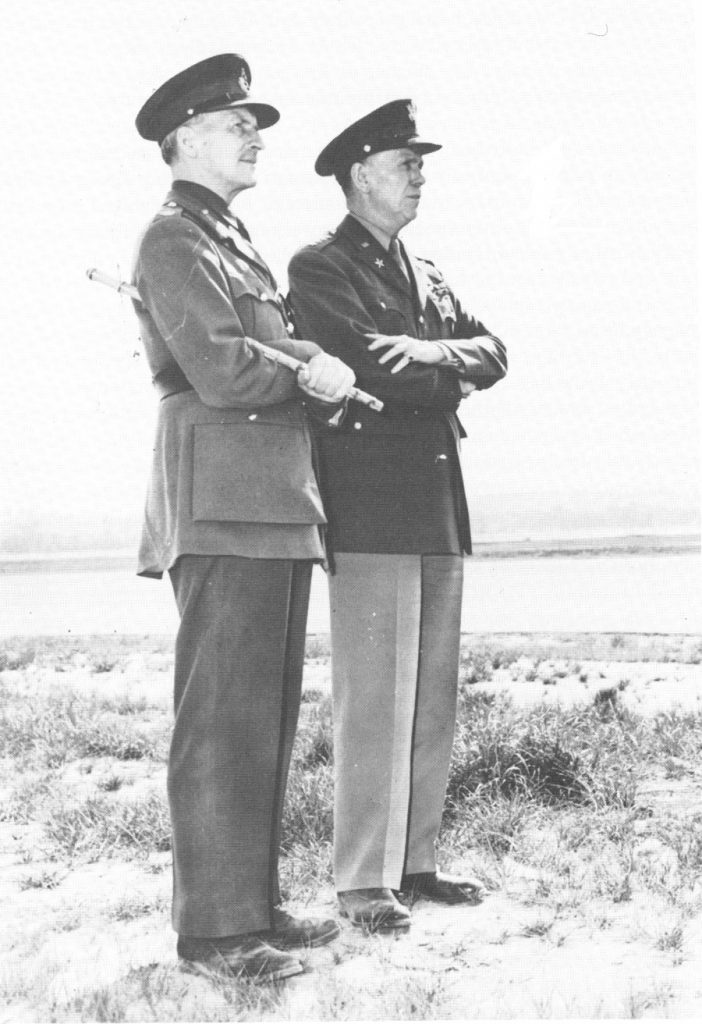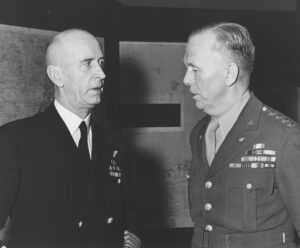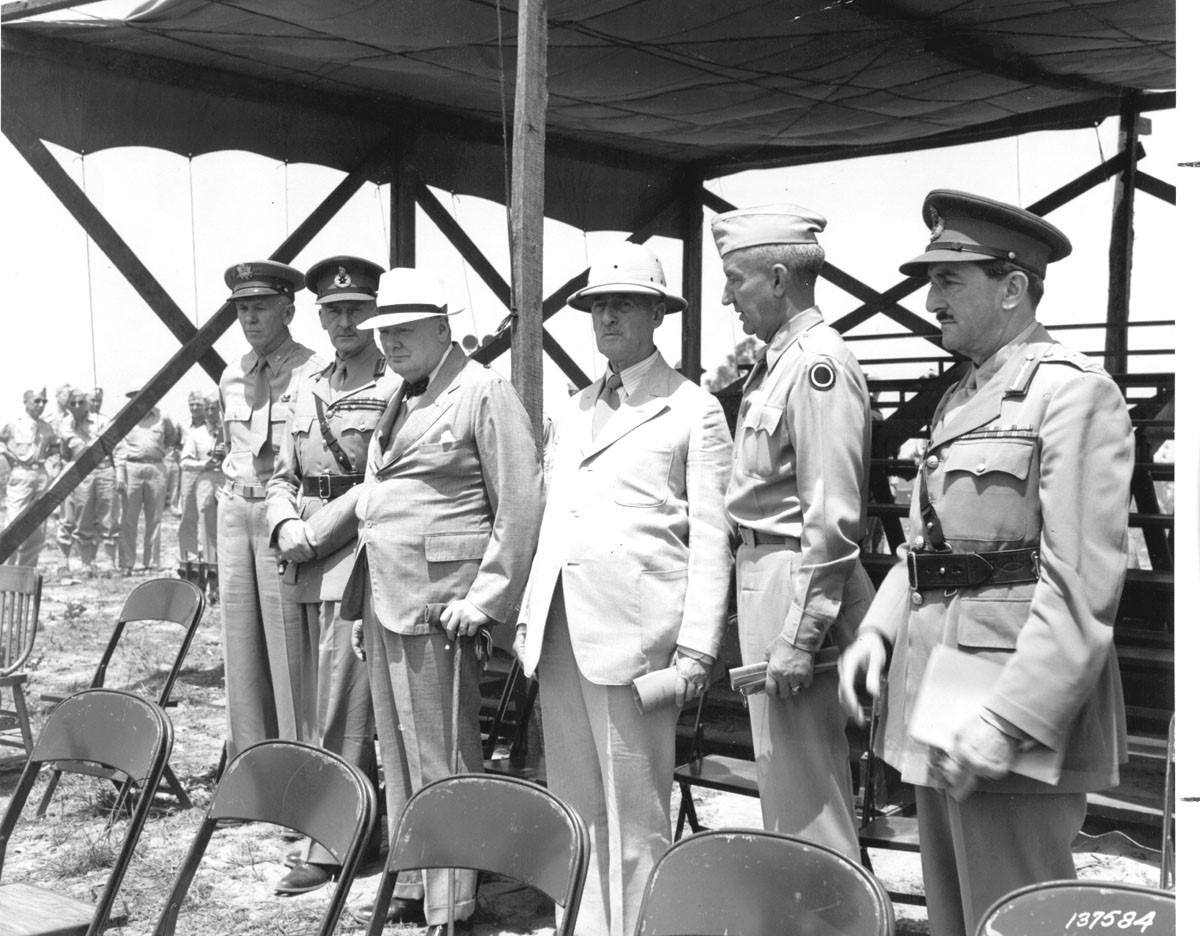June 1942
It was an inauspicious time for the Second Washington Conference to convene. The Allied position in the Mediterranean appeared to be in danger of collapse. On May 26 General Erwin Rommel’s forces had launched a vigorous attack on British positions in eastern Cyrenaica. Rommel smashed a British armored attack on June 5, and on June 12-13 he inflicted a still more staggering defeat on his opponents, practically stripping the British Eighth Army of its armor. By June 18 more than thirty-three thousand British Empire troops were surrounded in the port of Tobruk, a city they had triumphantly wrested from the Italian Army seven months previously. (I. S. O. Playfair, The Mediterranean and Middle East, volume 3, British Fortunes Reach Their Lowest Ebb, a volume in the History of the Second World War [London: HMSO, 1960], pp. 223-60.)
On the morning of June 19 General Marshall conferred with Prime Minister Winston S. Churchill in Washington. As the prime minister flew to Hyde Park for talks with President Roosevelt, Marshall sent the following telegram for the president. “General Marshall states your guest just talked to him. He is pessimistic regarding Bolero and interested in August Gymnast and another similar movement in Norway.” (Marshall Memorandum for Mr. McIntyre, June 19, 1942, GCMRL/G. C. Marshall Papers [Pentagon Office, Selected].) Secretary of War Henry L. Stimson recorded Marshall’s visit with Churchill in his diary:
Marshall told me that he had seen Churchill this morning up at the Embassy and that Churchill was full of discouragement and new proposals for diversions. Therefore the importance of a firm and united stand on our part is very important.
(June 19, 1942, Yale/H. L. Stimson Papers [Diary, 39: 101].)
Marshall and Stimson were apprehensive at the thought of Roosevelt and Churchill conferring at Hyde Park. On June 17 at a meeting at the White House the president had reopened the subject of an operation in North Africa (GYMNAST) which both Stimson and Marshall opposed. “The President sprung on us a proposition which worried me very much,” Stimson wrote. “It looked as if he was going to jump the traces over all that we have been doing in regard to BOLERO and to imperil really our strategy of the whole situation. He wants to take up the case of GYMNAST again, thinking that he can bring additional pressure to save Russia. The only hope I have about it at all is that I think he may be doing it in his foxy way to forestall trouble that is now on the ocean coming towards us in the shape of a new British visitor. But he met with a rather robust opposition for the GYMNAST proposition. Marshall had a paper already prepared against it for he had a premonition of what was coming. I spoke very vigorously against it.” (June 17, 1942, ibid., pp. 95-96.) On June 19 a letter from Stimson in defense of BOLERO was dispatched to President Roosevelt. Attached to Stimson’s letter was Marshall’s handwritten endorsement: “The enclosed paper has been read by me and by Generals Arnold, McNarney, Eisenhower and Handy. We all are in complete agreement with the Secretary of War.” (Marshall to the President, June 19, 1942, FDRL/F. D. Roosevelt Papers [PSF, Safe]. Stimson’s letter to Roosevelt is printed in Henry L. Stimson and McGeorge Bundy, On Active Service in Peace and War [New York: Harper and Brothers, 1948], pp. 420-23.)

Marshall and Dill, 1942, GCMF Photo.
While Roosevelt and Churchill talked at Hyde Park, United States and British military leaders held meetings in Washington on June 19 and 20. At an informal meeting on the nineteenth attended by Marshall, Eisenhower, Walter B. Smith, Dill, Brooke, and Ismay, the conferees agreed that “GYMNAST should not be undertaken under the existing situation,” and that both countries should “adhere firmly to the basic decision to push BOLERO with all possible speed and energy.” It was agreed that “the locality, strength and availability of means for any 1942 attack on Western Europe should be studied further. . . . Since any 1942 operation would inevitably have some deterring effect upon Continental operations in 1943, it should be undertaken only in case of necessity or if an exceptionally favorable opportunity presented itself.” (Department of State, Foreign Relations of the United States: The Conferences at Washington, 1941-1942, and Casablanca, 1943 [Washington: GPO, 1968], pp. 426-28.) At a meeting of the Combined Chiefs of Staff the next day, the secretary reported that “General Marshall said that large scale operations on the Continent in 1943 would clearly not be possible unless all efforts were concentrated now on their preparation. If we changed our plan now, and opened up another front, we should probably achieve nothing. If we went ahead, we should at least ensure the safety of the United Kingdom, whatever happened in Russia, and any change of plan could be made in about September when we knew what the situation on the Eastern front was going to be. To defeat the Germans we must have overwhelming power, and North West Europe was the only front on which this overwhelming superiority was logistically possible. . . . From the military point of view, therefore, there seemed no other logical course than to drive through with the Bolero Plan.” (Minutes of the Combined Chiefs of Staff Meeting, June 20, 1942, NA/ RG 165 [OCS, CCS 334, CCS Minutes].)
Meanwhile talks at Hyde Park were taking a different turn as Churchill and Roosevelt pushed for GYMNAST. Churchill presented Roosevelt with a memorandum on June 20 outlining the immediate strategic decisions before the Allies. “The continued heavy sinkings at sea constitute our greatest and most immediate danger,” Churchill began. “What further measures can be taken now to reduce sinkings other than those in actual operations which must be faced? When will this convoy start in the Caribbean and Gulf of Mexico? Is there needless traffic which could be reduced? Should we build more escort vessels at the expense of merchant tonnage, and if so to what extent?” Furthermore, the prime minister declared, unless a permanent bridgehead could be established on the Continent the British government was opposed to a cross-Channel operation. The government “would not favour an operation that was certain to lead to disaster for this would not help the Russians whatever their plight, would compromise and expose to Nazi vengeance the French population involved and would gravely delay the main operation in 1943. We hold strongly to the view that there should be no substantial landing in France this year unless we are going to stay.” Churchill maintained that “no responsible British military authority has so far been able to make a plan for September 1942 which had any chance of success unless the Germans become utterly demoralized, of which there is no likelihood.” If the American staff had a plan “which offers a reasonable prospect of success His Majesty’s Government will cordially welcome it and will share to the full with their American comrades the risks and sacrifices. . . . But in case no plan can be made in which any responsible authority has good confidence, and consequently no engagement on a substantial scale in France is possible in September 1942, what else are we going to do? Can we afford to stand idle in the Atlantic theatre during the whole of 1942? Ought we not be preparing within the general structure of BOLERO some other operation by which we may gain positions of advantage and also directly or indirectly to take some of the weight off Russia? It is in this setting and on this background that the operation GYMNAST should be studied.” (Churchill and Roosevelt: The Complete Correspondence, ed. Warren F. Kimball, 3 vols. [Princeton: Princeton University Press, 1984], 1: 515. See note 2, Marshall to Stark, June 18, 1942, Papers of George Catlett Marshall, #3-226 [239-41], for the leaders’ discussions of the atomic bomb project.)

Adm. King and Gen. Marshall in 1942. GCMF Photo.
Harry Hopkins forwarded a copy of Churchill’s memorandum in code to Captain John L. McCrea, the president’s naval aide, for General Marshall’s and Admiral King’s comments; but before the chief of staff could prepare his response (see Papers of George Catlett Marshall, #3-229 [3: 246-48]), the president and the prime minister moved their discussions to Washington. Their arrival on Sunday, June 21, coincided with the news—which General Lord Ismay called “a hideous and totally unexpected shock”—that the British garrison at Tobruk had surrendered. Marshall was hurriedly called to the White House for a series of meetings; he immediately agreed to send an armored division to the Middle East. (This offer was changed on June 25 to sending three hundred new tanks and one hundred self-propelled guns by fast convoy.) Tobruk’s fall reinforced Churchill’s determination that the Allies should mount a major operation in French North Africa, and to Marshall’s surprise and disappointment, the prime minister succeeded in getting a new draft agreement continuing BOLERO but emphasizing GYMNAST (The Memoirs of General Lord Ismay [New York: Viking Press, 1960], pp. 254-55; Foreign Relations, Conferences at Washington and Casablanca, pp. 433-35; June 21,1942, Yale/H. L. Stimson Papers [Diary, 39: 110-11].)
The long day’s final meeting, as described to Secretary Stimson by General Marshall, “had been called ostensibly for questions of naval cooperation between our Navy and the British in the South Pacific. But after that had been handled and when it was very late at night, the President suddenly suggested that we might throw a large American force into the Middle East and cover the whole front between Alexandria and Teheran. Marshall was of course terribly taken back and he said to the President that that was such an overthrow of everything they had been planning for, he refused to discuss it at that time of night in any way and he turned and went out of the room.” (June 22, 1942, Yale/ H. L. Stimson Papers [Diary, 39: 112].)

Marshall, Dill, Churchill, Stimson and others witness a parachute demonstration a few days later on June 24, 1942, GCMF Photo.
Note:
The Papers of George Catlett Marshall, ed. Larry I. Bland and Sharon Ritenour Stevens (Lexington, Va.: The George C. Marshall Foundation, 1981- ). Electronic version based on The Papers of George Catlett Marshall, vol. 3, “The Right Man for the Job,” December 7, 1941-May 31, 1943 (Baltimore and London: The Johns Hopkins University Press, 1991), pp. 242-246.
